A Cooperative Communication Protocol for QoS Provisioning in IEEE 802.11p/Wave Vehicular Networks
Abstract
:1. Introduction
2. WAVE Protocols and Model
3. Related Works
4. Proposed Scheme
4.1. Relay Node Selection
4.2. Resource Allocation Scheme for Cooperative Communication
4.3. Release of the Resource Reserved for the Cooperative Communication
5. Performance Evaluation
6. Conclusions
Author Contributions
Acknowledgments
Conflicts of Interest
References
- ASTM E2213-02: 2002. Standard Specification for Telecommunications and Information Exchange between Roadside and Vehicle Systems. Available online: https://www.astm.org/DATABASE.CART/HISTORICAL/E2213-02.htm (accessed on 19 September 2018).
- IEEE Standard 802.11p: 2010. IEEE Standard for Information Technology-Telecommunications and Information Exchange between Systems-Local and Metropolitan Area Networks-Specific Requirements Part 11: Wireless LAN Medium Access Control (MAC) and Physical Layer (PHY) Specifications. Available online: https://ieeexplore.ieee.org/document/5514475/ (accessed on 19 September 2018).
- Uzcategui, R.A.; Sucre, A.J.D.; Acosta-Marum, G. WAVE: A tutorial. IEEE Commun. Mag. 2009, 47, 126–133. [Google Scholar] [CrossRef]
- IEEE 1609.12: 2016. IEEE Standard for Wireless Access in Vehicular Environments (WAVE)—Identifier Allocations. Available online: https://standards.ieee.org/standard/1609_12-2016.html (accessed on 19 September 2018).
- IEEE 1609.2: 2016. IEEE Standard for Wireless Access in Vehicular Environments—Security Services for Applications and Management Messages. Available online: https://standards.ieee.org/standard/1609_2-2016.html (accessed on 19 September 2018).
- IEEE 1609.3: 2016. IEEE Standard for Wireless Access in Vehicular Environments (WAVE)—Networking Services. Available online: https://standards.ieee.org/standard/1609_3-2016.html (accessed on 19 September 2018).
- IEEE 1609.4: 2016. IEEE Standard for Wireless Access in Vehicular Environments (WAVE)—Multi-Channel Operation. Available online: https://standards.ieee.org/standard/1609_4-2016.html (accessed on 19 September 2018).
- Campolo, C.; Cortese, A.; Molinaro, A. CRaSCH: A cooperative scheme for service channel reservation in 802.11p/WAVE vehicular ad hoc networks. In Proceedings of the International Conference on Ultra Modern Telecommunications & Workshops, St. Petersburg, Russia, 12–14 October 2009; pp. 1–8. [Google Scholar]
- Lu, N.; Ji, Y.; Liu, F.; Wang, X. A dedicated multi-channel MAC protocol design for VANET with adaptive broadcasting. In Proceedings of the IEEE Wireless Communications and Networking Conference (WCNC), Sydney, NSW, Australia, 18–21 April 2010; pp. 1–6. [Google Scholar]
- Felice, M.D.; Ghandour, A.J.; Artail, H.; Bononi, L. Enhancing the performance of safety applications in IEEE 802.11p/WAVE Vehicular Networks. In Proceedings of the IEEE International Symposium on a World of Wireless, Mobile and Multimedia Networks (WoWMoM), San Francisco, CA, USA, 25 June 2012; pp. 1–9. [Google Scholar]
- Misra, S.; Krishna, P.V.; Saritha, V. LACAV: An energy efficient channel assignment mechanism for vehicular adhoc networks. J. Supercomput. 2012, 62, 1241–1262. [Google Scholar] [CrossRef]
- Wang, Q.; Leng, S.; Fu, H.; Zhang, Y. An IEEE 802.11p-based multichannel MAC scheme with channel coordination for vehicular ad hoc networks. IEEE Trans. Intell. Transp. Syst. 2012, 13, 449–458. [Google Scholar] [CrossRef]
- Wang, J.; Ji, Y.; Wang, X.; Liu, F. RSU-coordinated Multi-channel MAC with Multi-criteria Channel Allocation. In Proceedings of the International Conference on Connected Vehicles and Expo (ICCVE), Beijing, China, 15–31 August 2012; pp. 60–65. [Google Scholar]
- Dang, D.N.M.; Dang, H.N.; Do, C.T.; Hong, C.S. An Enhanced Multi-channel MAC for Vehicular Ad Hoc Networks. In Proceedings of the IEEE Wireless Communications and Networking Conference (WCNC), Shanghai, China, 7–10 April 2013; pp. 351–355. [Google Scholar]
- Dang, D.N.M.; Dang, H.N.; Nguyen, V.; Htike, Z.; Hong, C.S. HER-MAC: A Hybrid Efficient and Reliable MAC for Vehicular Ad Hoc Networks. In Proceedings of the IEEE 28th International Conference on Advanced Information Networking and Applications, Victoria, BC, Canada, 13–16 May 2014; pp. 186–193. [Google Scholar]
- Liu, L.; Wang, C.; Zhang, H.; Wu, L. Variable SCH interval multichannel medium access control scheme with unsaturated channel in VANETs. In Proceedings of the IEEE International Conference on Communication Systems (ICCS), Shenzhen, China, 14–16 December 2016; pp. 1–6. [Google Scholar]
- Song, C. Performance Analysis of the IEEE 802.11p Multichannel MAC Protocol in Vehicular Ad Hoc Networks. Sensors 2017, 17, 2890. [Google Scholar] [CrossRef] [PubMed]
- Lochert, C.; Hartenstein, H.; Tian, J.; Fussler, H.; Hermann, D.; Mauve, M. A routing strategy for vehicular ad hoc networks in city environments. In Proceedings of the IEEE Intelligent Vehicles Symposium, Columbus, OH, USA, 9–11 June 2003; pp. 156–161. [Google Scholar] [Green Version]
- Granelli, F.; Boato, G.; Kliazovich, D. MORA: A movement-based routing algorithm for vehicle ad hoc networks. In Proceedings of the IEEE Workshop on Automotive Networking and Applications (AutoNet 2006), San Francisco, CA, USA, 1 December 2006; pp. 1–7. [Google Scholar]
- Mo, Z.; Zhu, H.; Makki, K.; Pissinou, N. MURU: A multi-hop routing protocol for urban vehicular ad hoc networks. In Proceedings of the IEEE 3rd Annual International Conference on Mobile and Ubiquitous Systems—Workshops, San Jose, CA, USA, 17–21 July 2006; pp. 1–8. [Google Scholar]
- Taleb, T.; Sakhaee, E.; Jamalipour, A.; Hashimoto, K.; Kato, N.; Nemoto, Y. A Stable Routing Protocol to Support ITS Services in VANET Networks. IEEE Trans. Veh. Technol. 2007, 56, 3337–3347. [Google Scholar] [CrossRef]
- Zhao, J.; Cao, G. VADD: Vehicle-assisted data delivery in vehicular ad hoc networks. IEEE Trans. Veh. Technol. 2008, 57, 1910–1922. [Google Scholar] [CrossRef]
- Jarupan, B.; Ekici, E. PROMPT: A cross-layer position-based communication protocol for delay-aware vehicular access networks. Ad Hoc Netw. 2010, 8, 489–505. [Google Scholar] [CrossRef]
- Chen, Y.S.; Lin, Y.W.; Pan, C.Y. Dir: Diagonal-intersection-based routing protocol for vehicular ad hoc networks. Telecommun. Syst. 2001, 46, 299–316. [Google Scholar] [CrossRef]
- Katsaros, K.; Dianati, M.; Tafazolli, R.; Kernchen, R. CLWPR: A novel cross-layer optimized position based routing protocol for VANETs. In Proceedings of the IEEE Vehicular Networking Conference (VNC), Amsterdam, The Netherlands, 14–16 November 2011; pp. 139–146. [Google Scholar]
- Bernsen, J.; Manivannan, D. RIVER: A reliable inter-vehicular routing protocol for vehicular ad hoc networks. Comput. Netw. 2012, 56, 3795–3807. [Google Scholar] [CrossRef]
- Rezende, C.; Ramos, H.S.; Pazzi, R.W.; Boukerche, A.; Frery, A.C.; Loureiro, A.A.F. VIRTUS: A resilient location-aware video unicast scheme for vehicular networks. In Proceedings of the IEEE International Conference on Communications (ICC), Ottawa, ON, Canada, 10–15 June 2012; pp. 698–702. [Google Scholar]
- Wang, R.; Rezende, C.; Ramos, H.S.; Pazzi, R.W.; Boukerche, A.; Loureiro, A.A.F. LIAITHON: A location-aware multipath video streaming scheme for urban vehicular networks. In Proceedings of the IEEE Symposium on Computers and Communications (ISCC), Cappadocia, Turkey, 1–4 July 2012; pp. 436–441. [Google Scholar]
- Rondinone, M.; Gozalvez, J. Contention-based forwarding with multihop connectivity awareness in vehicular ad-hoc networks. Comput. Netw. 2013, 57, 1821–1837. [Google Scholar] [CrossRef]
- Sasaki, Y.; Lee, W.-C.; Hara, T.; Nishio, S. On alleviating beacon overhead in routing protocols for urban VANETs. In Proceedings of the IEEE 14th International Conference on Mobile Data Management, Milan, Italy, 3–6 June 2013; pp. 66–76. [Google Scholar]
- Huang, H.; Zhang, S. A routing algorithm based on dynamic forecast of vehicle speed and position in VANET. Int. J. Distrib. Sens. Netw. 2013, 9, 390795. [Google Scholar] [CrossRef]
- Rak, J. LLA: A New Anypath Routing Scheme Providing Long Path Lifetime in VANETs. IEEE Commun. Lett. 2014, 18, 281–284. [Google Scholar] [CrossRef]
- Lin, D.; Kang, J.; Squicciarini, A.; Wu, Y.; Gurung, S.; Tonguz, O. MoZo: A moving zone based routing protocol using pure V2V communication in VANETs. IEEE Trans. Mob. Comput. 2017, 16, 1357–1370. [Google Scholar] [CrossRef]
- Liu, L.; Xia, W.; Shen, L. An adaptive multi-channel MAC protocol with dynamic interval division in vehicular environment. In Proceedings of the International Conference on Information Science and Engineering, Nanjing, China, 26–28 December 2009; pp. 2534–2537. [Google Scholar]
- Li, X.; Hu, B.-J.; Chen, H.; Andrieux, G.; Wang, Y.; Wei, Z.-H. An RSU-coordinated synchronous multi-channel MAC scheme for vehicular ad hoc networks. IEEE Access 2015, 3, 2794–2802. [Google Scholar] [CrossRef]
- Chang, C.; Yen, H.; Deng, D. V2V QoS Guaranteed Channel Access in IEEE 802.11p VANETs. IEEE Trans. Depend. Secur. Comput. 2016, 13, 5–17. [Google Scholar] [CrossRef]
- Campolo, C.; Molinaro, A. Vehicle-to-roadside multihop data delivery in 802.11p/WAVE vehicular ad hoc networks. In Proceedings of the IEEE Global Telecommunications Conference, Miami, FL, USA, 6–10 December 2010; pp. 1–5. [Google Scholar]
- Standard J2735:2016. Dedicated Short Range Message Set (DSRC) Dictionary. Available online: https://www.sae.org/standards/content/j2735_201603/ (accessed on 19 September 2018).
- Liu, P.; Tao, Z.; Narayanan, S.; Korakis, T.; Panwar, S.S. CoopMAC: A cooperative MAC for wireless LANs. IEEE J. Sel. Areas Commun. 2007, 25, 340–354. [Google Scholar] [CrossRef]
- Guo, T.; Carrasco, R. CRBAR: Cooperative relay-based auto rate MAC for multirate wireless networks. IEEE Trans. Wirel. Commun. 2009, 8, 5938–5947. [Google Scholar] [CrossRef]
- OMNeT++—Object-Oriented Discrete Event Simulation System. Available online: http://www.omnetpp.org/ (accessed on 19 September 2018).
- Shi, C.; Zhao, H.; Garcia-Palacios, E.; Ma, D.; Wei, Z. Distributed interference-aware relay selection for IEEE 802.11 based cooperative networks. IET Netw. 2012, 1, 84–90. [Google Scholar] [CrossRef]
- Shan, H.; Zhuang, W. Distributed Cooperative MAC for Multihop Wireless Networks. IEEE Commun. Mag. 2009, 47, 126–133. [Google Scholar] [CrossRef]
- Palombara, C.L.; Tralli, V.; Masini, B.; Conti, A. Relay-assisted diversity communications. IEEE Trans. Veh. Technol. 2013, 62, 415–421. [Google Scholar] [CrossRef]
- Al-Hourani, A.; Kandeepan, S.; Hossain, E. Relay-assisted device-to-device communication: A stochastic analysis of energy saving. IEEE Trans. Mob. Comput. 2016, 15, 3129–3141. [Google Scholar] [CrossRef]
- Zanella, B.; Bazzi, A.; Masini, B.M.; Pasolini, G. Performance analysis of multiuser 2-hop systems with random placement of relay nodes. In Proceedings of the IEEE Global Telecommunications Conference, Austin, TX, USA, 8–12 December 2014; pp. 4174–4179. [Google Scholar]
- Sen, I.; Matolak, D.W. Vehicle-vehicle channel models for the 5-GHz band. IEEE Trans. Intell. Transp. Syst. 2008, 9, 235–245. [Google Scholar] [CrossRef]
- Cheng, L.; Benjamin, E.H.; Stancil, D.D.; Bai, F.; Mudalige, P. Mobile vehicle to vehicle narrowband channel measurement and characterization of the 5.9 GHz DSRC frequency band. IEEE J. Sel. Areas Commun. 2007, 25, 1501–1516. [Google Scholar] [CrossRef]
- Acosta, G.; Ingram, M.A. Six time and frequency selective empirical channel models for vehicular wireless LANs. IEEE Veh. Technol. Mag. 2007, 2, 4–11. [Google Scholar] [CrossRef]
- Goldsmith, A. Wireless Communication; Cambridge University Press: Cambridge, UK, 2005; ISBN 9780511841224. [Google Scholar]
- Panichpapiboon, S.; Pattara-Atikom, W. Connectivity requirements for a self-organizing traffic information systems. IEEE Trans. Veh. Technol. 2008, 57, 3333–3340. [Google Scholar] [CrossRef]
- Panichpapiboon, S.; Ferrari, G.; Tonguz, O.K. Optimal transmit power in wireless sensor networks. IEEE Trans. Mob. Comput. 2006, 5, 1432–1447. [Google Scholar] [CrossRef]







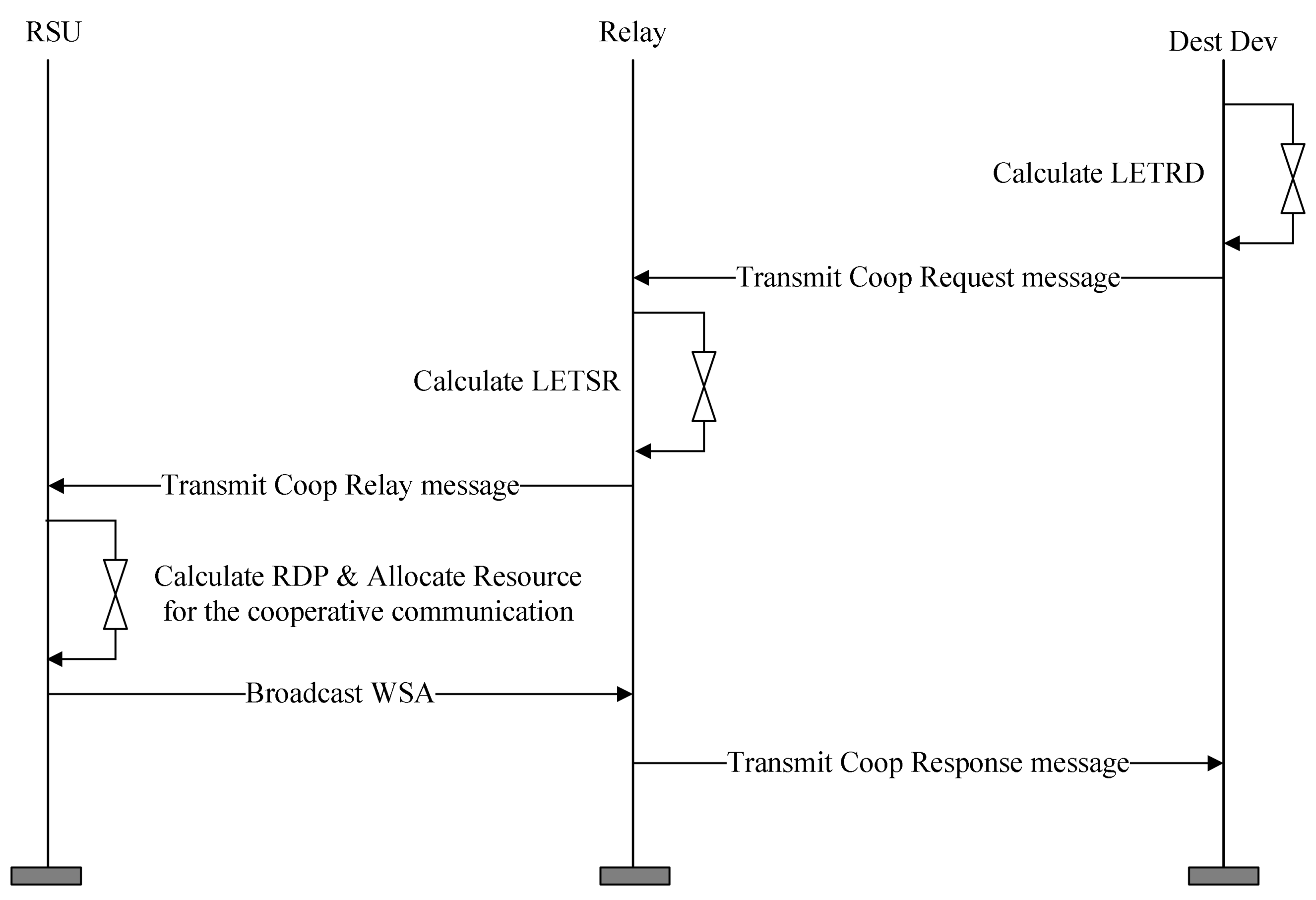

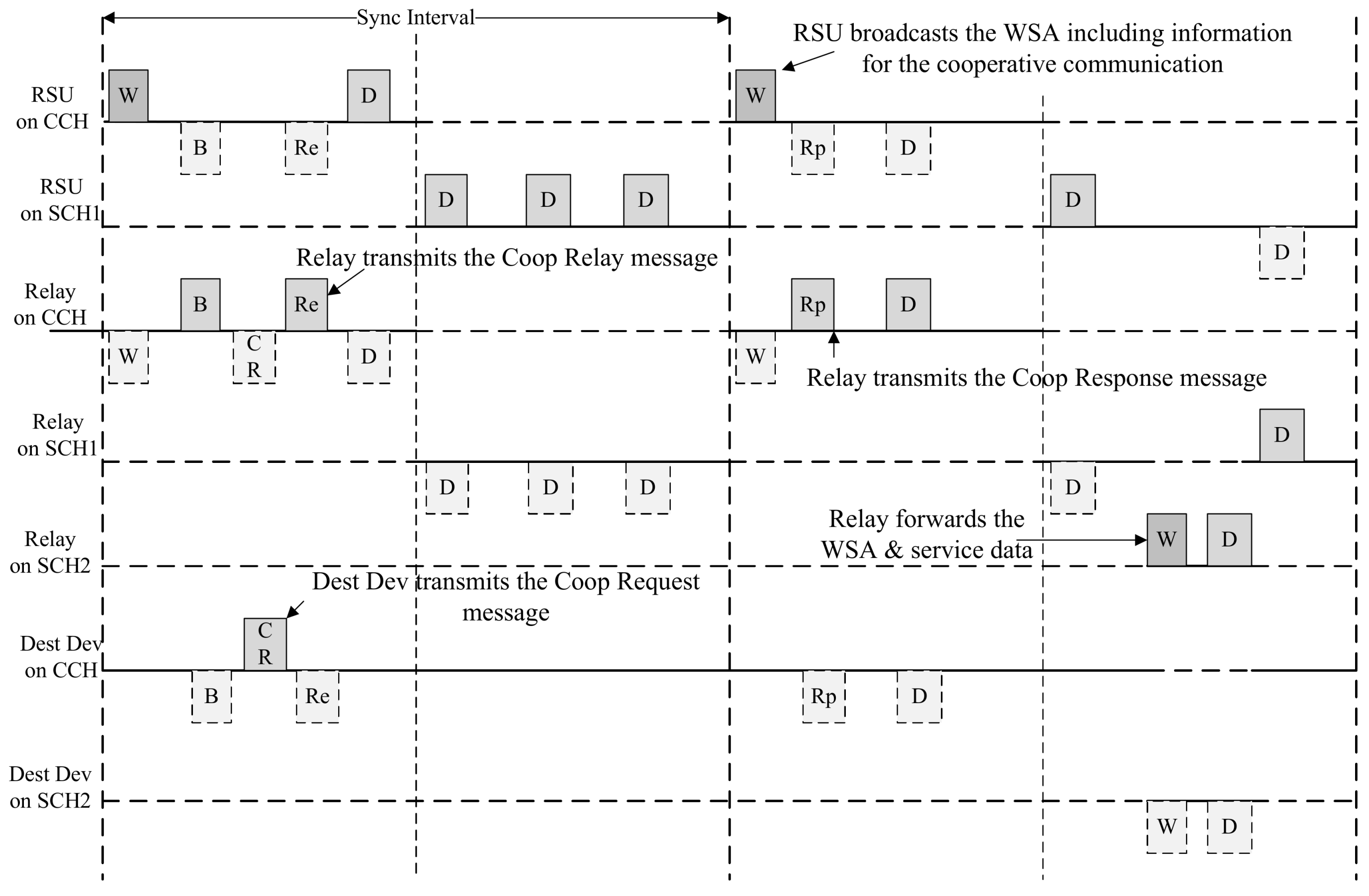



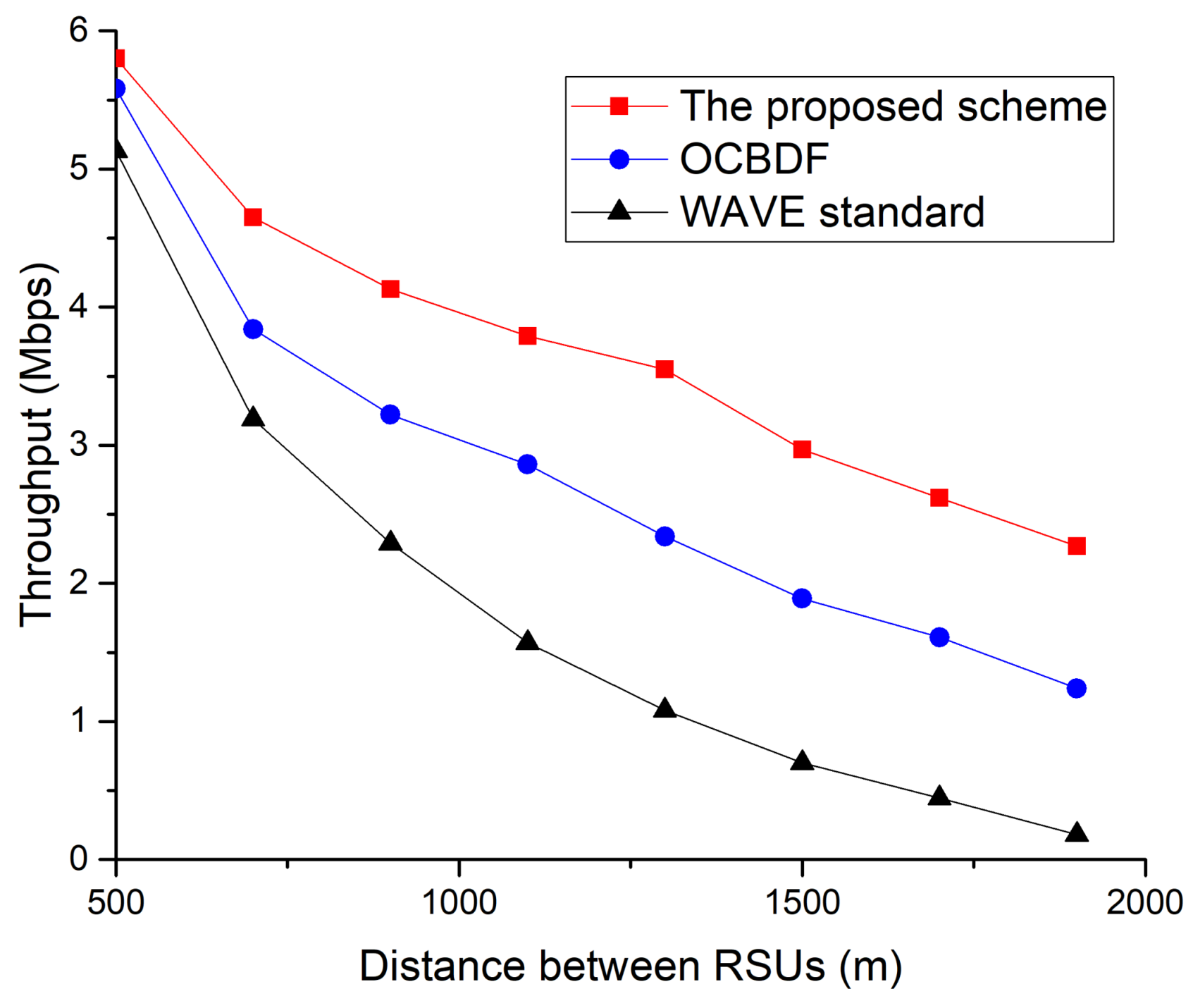

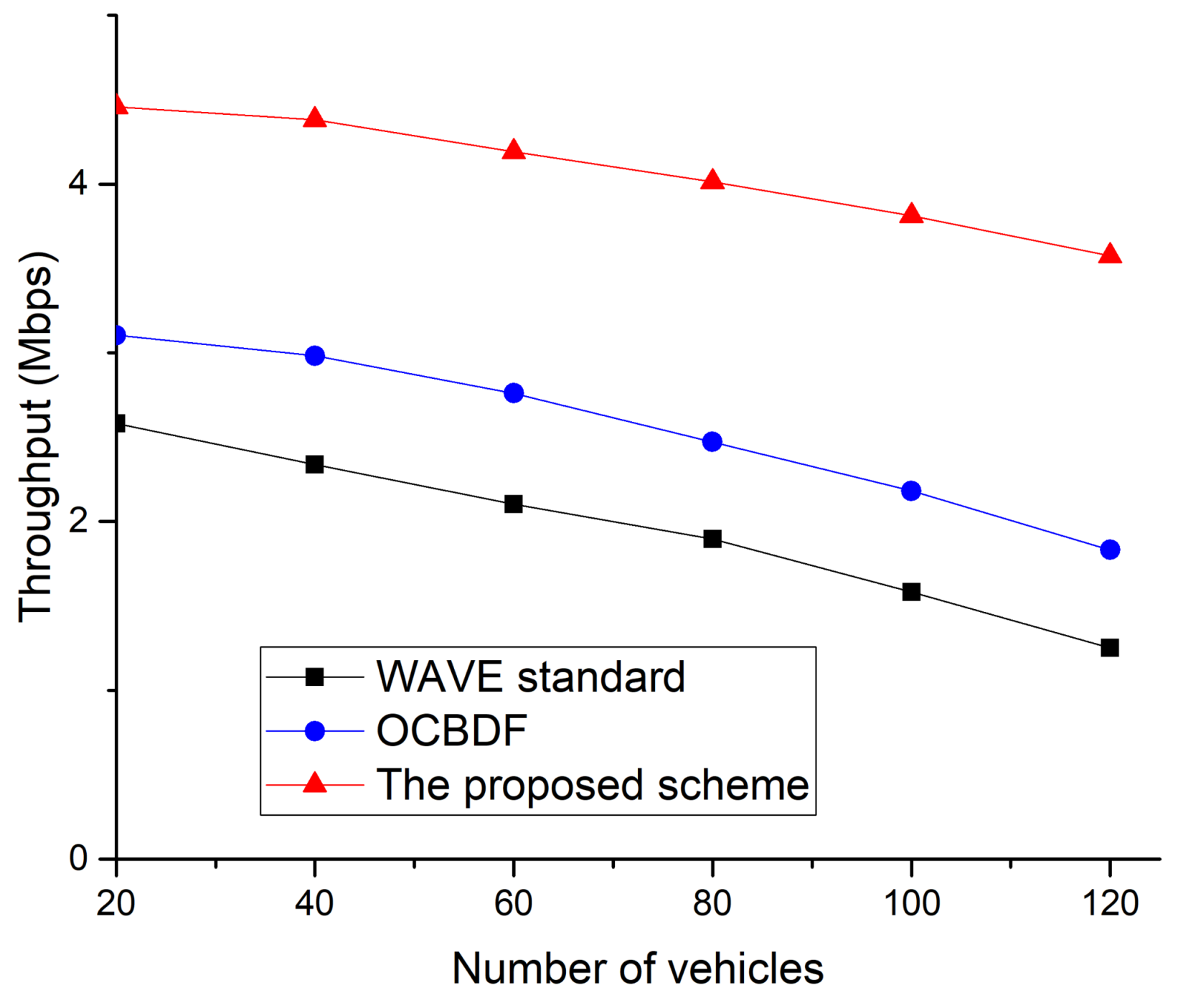
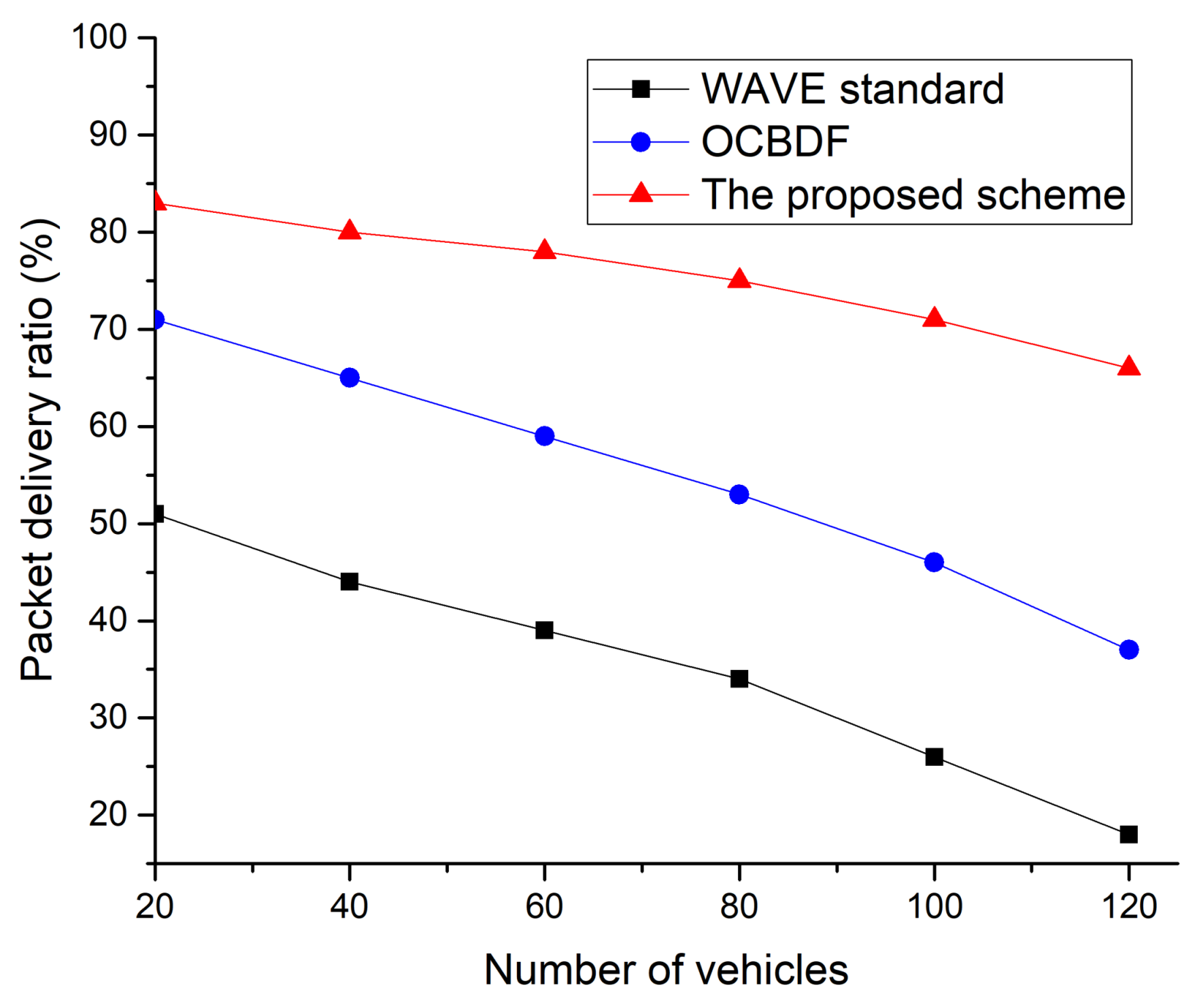
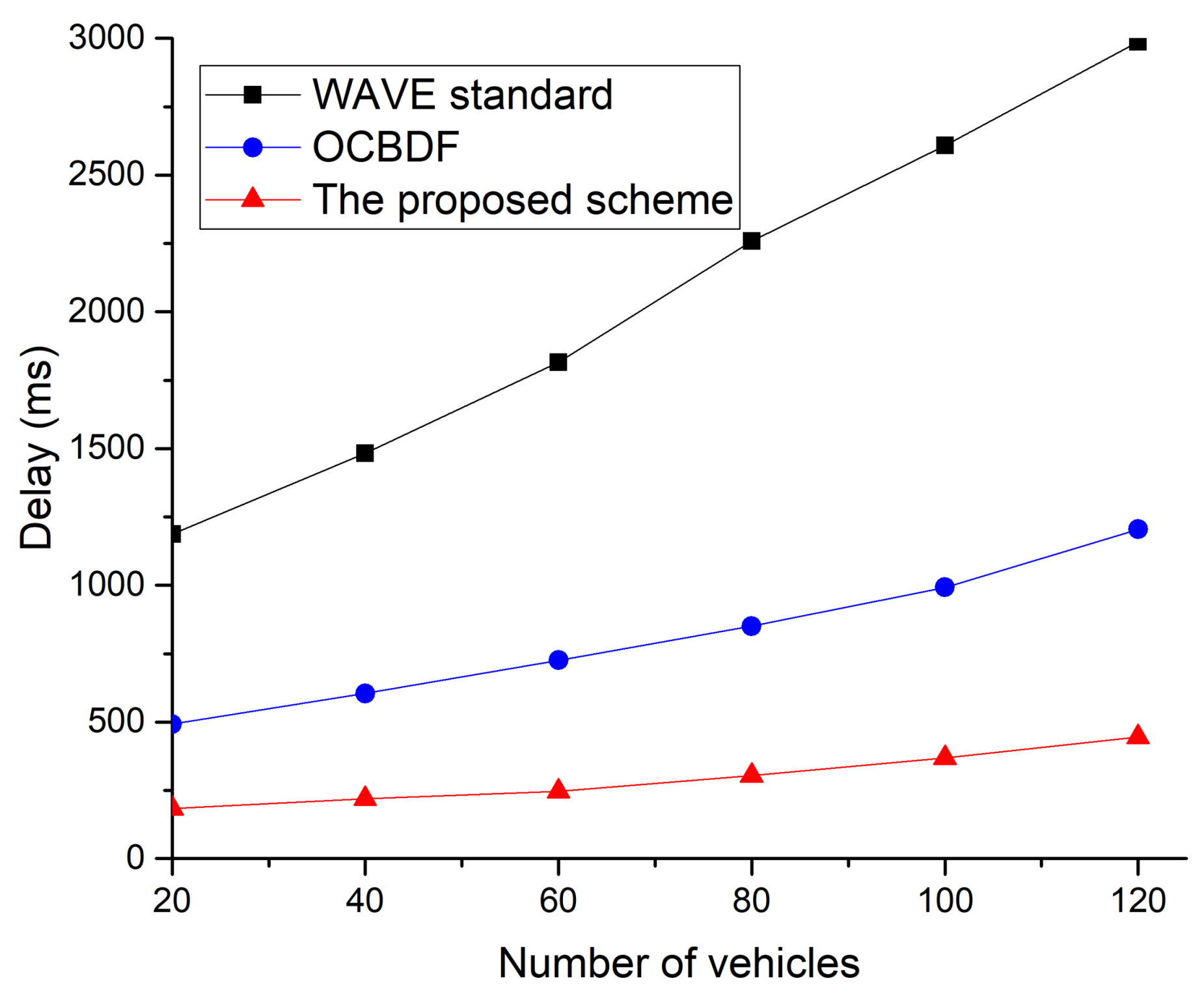
| Country/Region | Frequency Band |
|---|---|
| ITU-R (ISM band) | 5725–5875 |
| Europe | 5795–5815, 5855/58755905/5925 |
| North America | 902–928, 5850–5925 |
| Japan | 715–725, 5770–5850 |
| Type | Description | Size (byte) |
|---|---|---|
| DSRCmsgID | Data elements used in each message to define the Message type | 1 |
| MsgCount | It can check the flow of consecutive messages having the same DSRCmsgID received from the same message sender. | 1 |
| TemporaryID | Represents a 4-byte temporary device identifier. When used in a mobile OBU device, this value is periodically changed to ensure anonymity. | 4 |
| Dsecond | Represents two bytes of time information. | 2 |
| Latitude | Represents the geographic latitude of an object. | 4 |
| Longitude | Represents the geographic longitude of an object. | 4 |
| Elevation | Represents an altitude measured by the WGS84 coordinate system. | 2 |
| PositionAccuracy | Various quality parameters used to model the positioning accuracy for each given axis. | 4 |
| TransmissionAndSpeed | Represents the speed of the vehicle. | 2 |
| Heading | The current direction value is expressed in units of 0.0125 degrees. | 2 |
| SteeringWheelAngle | Represents the current steering angle of the steering wheel. | 1 |
| AccelerationSet4Way | It consists of three orthogonal directions of acceleration and yaw rate. | 7 |
| BrakeSystemStatus | Represents a data element that records various control states related to braking of the vehicle. | 2 |
| VehicleSize | Represents the length and width of the vehicle. | 3 |
| Parameters | Value |
|---|---|
| Frequency band | 5.8 GHz |
| Physical/MAC Layer | IEEE 802.11p |
| Tx Power RSU | 50 mW (500 m radio range) |
| Tx Power OBU | 11 mW (250 m radio range) |
| Distance between neighboring RSUs | 500 m ~ 2000 m |
| Average speed | 35 Km/h (default) ~ 100 Km/h |
| Simulation Time | 600 s |
| Data Packet Length | 512 Byte |
© 2018 by the authors. Licensee MDPI, Basel, Switzerland. This article is an open access article distributed under the terms and conditions of the Creative Commons Attribution (CC BY) license (http://creativecommons.org/licenses/by/4.0/).
Share and Cite
Kim, J.-W.; Kim, J.-W.; Jeon, D.-K. A Cooperative Communication Protocol for QoS Provisioning in IEEE 802.11p/Wave Vehicular Networks. Sensors 2018, 18, 3622. https://doi.org/10.3390/s18113622
Kim J-W, Kim J-W, Jeon D-K. A Cooperative Communication Protocol for QoS Provisioning in IEEE 802.11p/Wave Vehicular Networks. Sensors. 2018; 18(11):3622. https://doi.org/10.3390/s18113622
Chicago/Turabian StyleKim, Jin-Woo, Jae-Wan Kim, and Dong-Keun Jeon. 2018. "A Cooperative Communication Protocol for QoS Provisioning in IEEE 802.11p/Wave Vehicular Networks" Sensors 18, no. 11: 3622. https://doi.org/10.3390/s18113622




